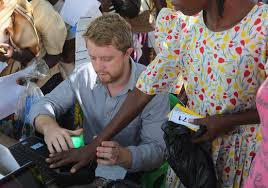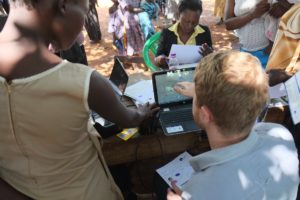How do you verify individuals’ identities in a country where identification documentation is not prevalent and personal data is non-existent?
In fact, this is a massive problem faced by anti-poverty programs worldwide. Organizations from national governments to NGOs struggle with how to accurately and safely identify their beneficiaries, especially in regions that lack reliable infrastructure for this purpose.

This is also a specific challenge GiveDirectly faced in Uganda. In order to implement our cash transfer program, we need to verify identities during multiple steps in the process. Yet only about 5% of our recipients have nationally-recognized documentation and, of those who do, most have paper-based documentation that can be imitated.
To ensure that the right recipient is receiving our cash transfers, we traditionally had a third party run face-matching checks off of pictures of the recipient taken by GiveDirectly staff. This test has good features – it is reliable and thorough – but also some drawbacks – it takes the results and management out of our direct control and is time consuming.
We wanted to see if we could find an even better identification process, so we decided to try biometrics. The use of biometrics in development settings is rare, and palm vein readers, the biometrics technology we opted to use, is even rarer. Piloting this technology put GiveDirectly on the cutting edge of identification methods, and allowed us to start answering important questions related to biometrics implementation.
Any changes to operations bring concerns: How will our recipients respond? How effective will the technology be with our recipients and in the rural environment? Do we have the infrastructure and systems to incorporate this new technology into our processes?
Even with all of these concerns, we were impressed with the results. First, 100% of our recipients agreed to participate in the trial (even though we made it optional). Second, the technology used provided highly accurate results: only about <0.5% of recipient scans produced false negatives and <3% produced false positives. When most people think of biometrics, they think of thumbprints or iris scans, but palm vein readers are even more accurate. And in the rare case the wrong recipient information appears after scanning, palm vein readers easily allow GiveDirectly staff to re-scan recipients. And finally,the systems were fast – on average, registrations took 15 seconds and verification took three seconds.

We’re excited about these results for three major reasons:
- Increased security: Biometrics assure us that the real recipient has come to collect their money. Avenues for potential fraud, such as identity fraud or similar schemes, are mitigated through this very reliable palm vein reader technology. As we scale, security will become more and more important.
- Increased number of eligible recipients: Confidence in our identification processes is imperative to our operations. Without it, certain groups of people would likely be excluded from our areas of operation, including transient communities and refugees. Biometrics allows us to potentially target these individuals in the future, increasing the number of potentially eligible recipients who can benefit from this highly effective intervention.
- Innovating secure, reliable technologies: Having pioneered palm vein technology with considerable success, we can share our processes with other organizations to continue pushing boundaries on best practices of verifying recipient identities. And with our own rigorous identification methods, GiveDirectly can work with more organizations in a broader range of contexts.
There is still an ongoing, internal debate about the cost and benefits of using biometrics within our operation. It might not be suitable for all of GiveDirectly’s processes, but it’s a fantastic additional tool that we are now confident we can use on short notice, in challenging environments.
***
Stuart Skeates was GiveDirectly’s first Country Director of Uganda operations. Currently, he is an MBA candidate at Harvard Business school and he previously worked for McKinsey & Company.